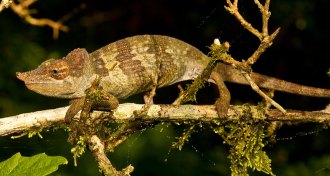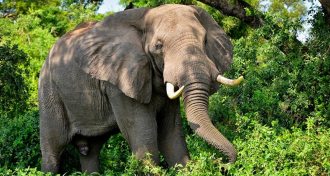Search Results for: Forests
Skip to resultsCan’t find what you’re looking for? Visit our FAQ page.
5,526 results for: Forests
-
 Animals
AnimalsScientists find a crab party deep in the ocean
A trip to check out the biodiversity off the coast of Panama revealed thousands of crabs swarming on the seafloor.
-
 Life
LifeNew habitat monitoring tools find hope for tigers
Free tools such Google Earth Engine and Global Forest Watch show there’s still enough forest left for tigers — if it’s protected.
By Susan Milius -
 Animals
AnimalsClimate change now bigger menace than forest loss for snowshoe hares
Shorter snow seasons push climate change ahead of direct habitat loss as menace for Wisconsin snowshoe hares.
By Susan Milius -
 Paleontology
PaleontologyDisney’s ‘The Jungle Book’ resurrects giant extinct ape
Disney’s latest version of ‘The Jungle Book’ features Gigantopithecus, the largest known ape ever to have lived.
By Erin Wayman -
 Animals
AnimalsNew chameleon has strange snout, odd distribution
A new species of chameleon from Tanzania echoes the unusual range of the kipunji monkey.
By Susan Milius -
 Animals
AnimalsGreat tits sing with syntax
Humans are no longer the only species to use compositional syntax. Great tits do, too.
-
 Health & Medicine
Health & MedicineEfforts to control mosquitoes take on new urgency
The major mosquito that is spreading Zika virus has quirks that make it one of the toughest to fight.
By Susan Milius -
 Animals
AnimalsIs Amy Tan actually ‘thrilled’ a leech is named after her?
Novelist Amy Tan answers a lingering question about celebrities honored in scientific names of new species — her namesake is a leech.
By Susan Milius -
 Archaeology
ArchaeologyEaster Island people used sharpened stones as tools, not weapons
Sharp-edged stone tools enabled daily survival, not warfare, on Easter Island.
By Bruce Bower -
 Climate
ClimateForest management not so hot at fighting warming
Forest management practices in Europe have slightly worsened climate change, new research shows.
-
 Animals
AnimalsWithout a ban on trade in old ivory, elephant killing continues
Samuel Wasser has been working to track down where poached ivory comes from. But to stop the killing, he says, a ban on the ivory trade is necessary.
-
 Quantum Physics
Quantum PhysicsUltrasmall engines bend second law of thermodynamics
Car engines and batteries run because of the second law of thermodynamics, which appears to work, with just a little bending, for ultrasmall engines in the quantum realm as well.
By Andrew Grant